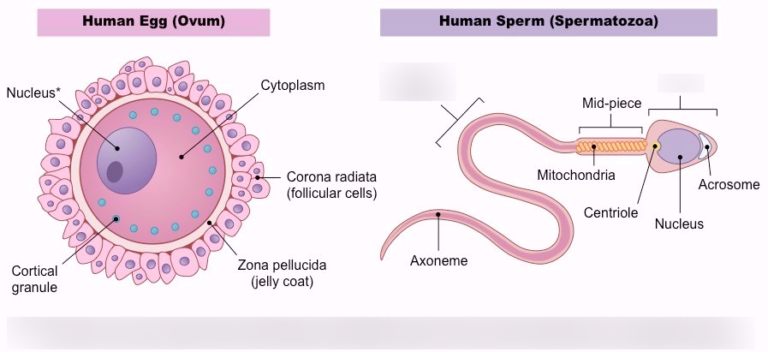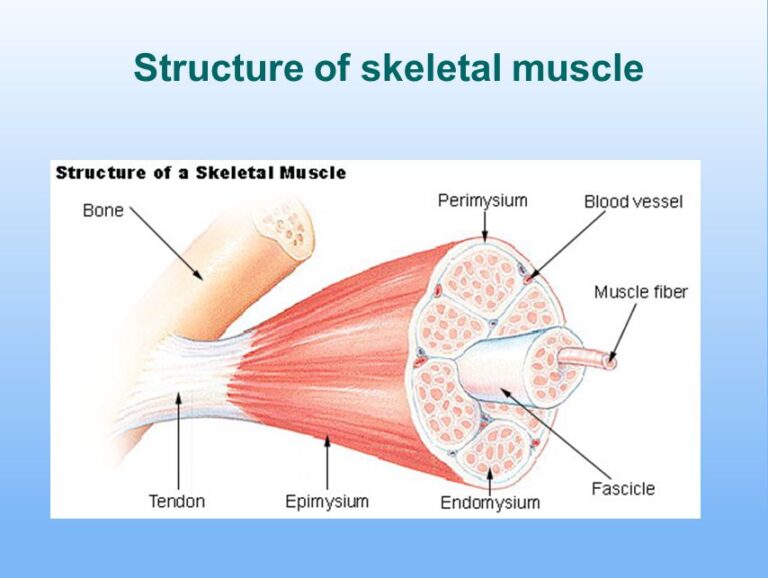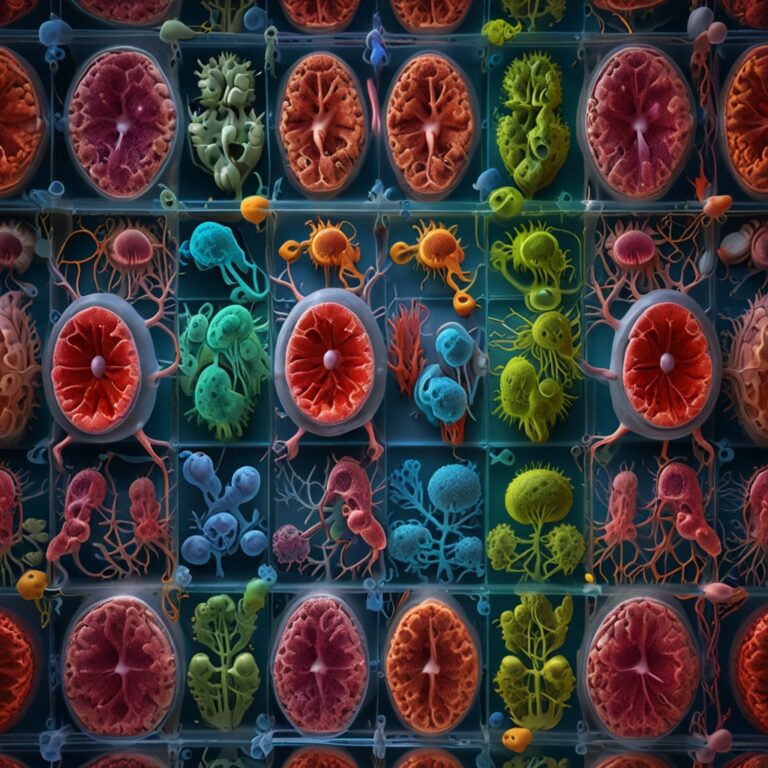The Cell
A cell is the basic structural and functional unit of life or in living organisms. It cannot be broken down into any simpler unit even though it contains of cell organelles. It carries out living functions and tasks. It is very small (microscopic) and can be viewed under a microscope.
Animal Cells

Plant Cells

*Note that animal cells don’t have a fixed shape, but plant cells have a more similar fixed shape compared to similar cells.
Functions of Cell Organelles
Nucleus: Contains genetic material in chromosomes which control how cells grow and work; Controls cell division (this is where the threads of chromatin fibre become stiff structures called chromosomes); There are 46 chromosomes in a common human cell (except sperm and egg – 23 each); They aren’t present in Red Blood Cells and prokaryotes; Chromosomes made of DNA which is the hereditary material present on chromosomes.
*Note: when a zygote (the first cell of life) is formed, it contains each and every gene (about 30 – 40,000). Thus, when cell division takes place, each and every gene is present in all cells, but in the human body, for example insulin, is only produced in the pancreas because that is where it is produced, but the DNA (carries coded instructions for controlling the activities and characteristics of the cell) in all cells will have the coded instruction to produce insulin.
Cytoplasm: It is the fluid present between the nucleus and the cell membrane; Contains water and dissolved substances such as sugars and salts; Organelles such as mitochondria (which produces energy – powerhouse of the cell) and ribosomes (produces proteins) are present in the cytoplasm.
Cell Membrane: It surrounds the cytoplasm; Controls the entry and exit of dissolved substances; It is partially permeable or semi-permeable as it only allows small particles and not large molecules of useful substances and nutrients; Protects other cell organelles and doesn’t allow the cell to burst; Gives the cell shape.
*The above 3 organelles are common to plant and animal cells.
Organelles Particularly in Animal Cells
Secretory Vesicles: Contains cell products such as hormones and enzymes; They secrete (remove useful substances from them to the body – different term than excrete) and store these cell products; Safely transport substances from one part of the cell to another.
Temporary Vacuole: This is small and temporary; Stores water and other substances; Not the same as the sap vacuole.
Glycogen: Storage form of carbohydrates; Present in liver or muscle cells only; Used for providing energy to the body when there is a shortage of glucose.
Plant Tissues and Cells
When studying a plant cell, one mostly studies a palisade mesophyll cell from the mesophyll layer of the leaf tissue.
Leaf Organelles
Cellulose Cell Wall: Made out of cellulose, the cell wall gives rigidity and support to the cell; it gives a fixed shape to the cell; freely permeable – will allow large molecules also to enter.
Sap or Large Vacuole: The vacuole is permanent and large in the plant cell as it stores water that also keeps the cell rigid as plants have no backbone or exoskeleton for support; may store ions and molecules (these mixed with water are called the cell sap); if the vacuole is full of water, the cell will be tight or turgid; if it loses water it becomes lose or flaccid. Osmosis makes sure that the vacuole become turgid once again.
Chloroplasts: They contain a pigment called chlorophyll which is green and gives the leaf its colour and absorbs light for photosynthesis and contains enzymes which help in the same process; starch is the insoluble stored form of carbohydrates which is produced from the glucose produced in photosynthesis.
Similarities and Differences in Plant and Animal Cells
Similarities
- Have a cell membrane, cytoplasm and a nucleus which has chromosomes, containing DNA material, containing genes.
- Stores carbohydrates in an insoluble form.
Differences
- Plants store carbohydrates as starch, whereas animals store it as glycogen.
- Plants are autotrophic and animals are heterotrophic, resulting in some differences.
- Plant cells have a cellulose cell wall to give support and rigidity and shape to the cell and a vacuole storing water also giving support as plants have no backbone or exoskeleton.
- Plant cells are larger in size due to the large vacuole and have a fixed or regular shape, whereas animal cells are smaller and have an irregular shape.
- The vacuole pushes the nucleus to the side in plant cells, whereas the nucleus is usually in the centre of animal cells.
- Plant cells are green due to the chlorophyll pigment in the chloroplasts

▲ Other than these specific organelles, animal cells do have secretory vesicles, glycogen and a small and temporary vacuole.
Other Organelles
The cytoplasm of all cells contains structures such as ribosomes on rough endoplasmic reticulum and vesicles. These can only be seen under an electron microscope.
Almost all cells, except prokaryotes, have mitochondria and rough endoplasmic reticulum.
Ribosomes are responsible for protein synthesis in cells and they lie on top of rough structures called endoplasmic reticulum and thus they are known as rough endoplasmic reticulum. Aerobic respiration takes place in mitochondria. Cells with high rates of metabolism require large numbers of mitochondria to provide sufficient energy.
The rough line like structures below the ribosomes are the rough endoplasmic reticulum.


Organisation of the Organism

A few more examples of the organisation:

Specialized Cells
Large organisms are multicellular and have many different types of cells, each specialized for a particular function. Each of these cells have a different structure which is suitable to perform its specialized task.
Red Blood Cell (RBC): Transports oxygen from lungs to tissues and back; has a red pigment called haemoglobin, which carries the oxygen (iron is required for the production of haemoglobin – if there is less iron in the diet, lesser haemoglobin, lesser oxygen carries, lesser respiration, lesser energy – deficiency disease known as anaemia); has no nucleus so that it can carry more haemoglobin, thus having more space for oxygen; flexible so that it can fit through the narrowest blood vessels – capillaries; exchanges carbon dioxide and oxygen through diffusion (the net movement of particles from a region of their higher concentration to a region of their lower concentration); has a biconcave shape formed as it has no nucleus which gives the cell a larger surface area so that diffusion can occur easily.

Muscle Cell: Proteins build up muscles; muscle cells contain many protein fibres in their cytoplasm which grow bigger or build up when more protein is consumed in the diet; contracts when doing work and relaxes; contracts so as to bring structures together; bones and muscles are always present together (interdependent) and they are connected by structures called tendons (inelastic structures, unlike muscle cells); when muscles aren’t used, they shrink as the proteins leave the cells making them smaller; when muscles contract, they may pull the tendon up, which allows the entire bone to move up; muscles usually work in pairs called antagonistic pairs (muscles that do opposing actions) (biceps – flexor muscles and triceps – extensor muscle are one such pair. When a bicep contracts, the hand will bend and the tricep will be relaxed and visa versa as the hand extends).

Ciliated Cells (also known as ciliated epithelial cell): Have cilia present (hair like structures present in the trachea (wind pipe) which constantly move upwards (lashing motion) to stop dust and microorganisms trapped on mucus from entering the lungs); goblet cells are present between a few ciliated cells to produce mucus (present even in stomach, intestine lining and nose); ciliated cells makes sure mucus doesn’t go down the wind pipe due to gravity; cough and sneezing clears out the extra mucus.

Nerve Cell / Neuron: Bundles of such cells connect together to form nerves; these nerves are deep inside the skin as when these cells are damaged they cannot be repaired, thus making it difficult to be damaged easily; this cell damage can lead to paralysis (if the nerve cell on the bottom of the spinal chord is damaged severely, the parts of the body below it or connected to the damaged nerve will not function); conducts nerve impulses in the form of electricity; have a long structure called the axon which allows these impulses to transfer and a body structure called the cyton or cell body which receives these impulses; has a fatty or myelin sheath to provide insulation of electric impulses and has many branched endings which connect to other nerves; one neuron can be very long and connect from a fingertip to the backbone.

Reproductive Cells:
| SPERM CELL | REPRODUCTION | ✓THE HEAD CONTAINS THE GENETIC MATERIAL FOR FERTILISATION IN A HAPLOID NUCLEUS(CONTAINING HALF THE NORMAL NUMBER OF CHROMOSOMES) ✓THE ACROSOME IN THE HEAD CONTAINS DIGESTIVE ENZYMES SO THAT A SPERM CAN PENETRATE AN EGG ✓ THE MID-PIECE IS PACKED WITH MITOCHONDRIA TO RELEASE ENERGY NEEDED TO SWIM AND FERTILISE THE EGG ✓ THE TAIL ENABLES THE SPERM TO SWIM |
| EGG CELL (OVUM) | REPRODUCTION | ✓ CONTAINS A LOT OF CYTOPLASM WHICH HAS NUTRIENTS FOR THE GROWTH OF THE EARLY EMBRYO ✓ HAPLOID NUCLEUS CONTAINS THE GENETIC MATERIAL FOR FERTILISATION ✓ CELL MEMBRANE CHANGES AFTER FERTILISATION BY A SINGLE SPERM SO THAT NO MORE SPERM CAN ENTER |

Root Hair Cell: Have an extension called a root hair which has an increased surface area for more absorption of water and mineral ions; have a large vacuole for more water storage; no chloroplasts; absorbs materials from soil water.

Xylem Vessel: present in the stem of a plant; transports water and minerals upwards to the rest of the plant from the roots; supports the plant (has lignin and cellulose cell wall for more support); thick wall stiffened and strengthened with this lignin (gives rigidity); no end-walls or end to end placement between cells to form a continuous tube; involved in the ascent of sap (upward flow of water and minerals); no cytoplasm, nucleus and other organelles (dead – lignin mostly in dead cells) so that water can pass through easily.

Palisade Mesophyll Cell:
| PALISADE MESOPHYLL CELL | PHOTOSYNTHESIS | ✓ COLUMN SHAPED TO MAXIMIZE ABSORPTION OF SUNLIGHT AND FIT AS MANY IN A LAYER UNDER THE UPPER EPIDERMIS OF THE LEAF AS POSSIBLE ✓ CONTAINS MANY CHLOROPLASTS FOR MAXIMUM PHOTOSYNTHESIS |

Tissues
Groups of specialized cells form a specialized tissue. There are several tissues which are present in animals and plants.
Animal Tissues
Epithelium: Outer tissue; lines tubes such as the gut (stomach + intestines); also covers surfaces such as skin; may look different in different places due to different functions.

Connective: Binds and strengthens other tissues (tendons – muscle to bone and ligaments – bone to bone).

Blood: Transport substances around the body 1 and defends against diseases 2.
Made up of 4 parts: Plasma, RBC, WBC and Platelets.
- RBC carries O2 , CO2 around the body with the presence of haemoglobin and transports glucose, fatty acids and glycerol, amino acids, hormones and urea in the plasma. Blood is liquid for it to be easier to transport.
- WBC fights diseases and platelets help in the clotting of blood to stop blood loss and the entry of foreign organisms into the body (indirectly defending against diseases).
*Plasma is a golden-yellow liquid which makes up most of the blood, but blood is red due to the number of RBC’s in the limited area, which is a very large amount. Centrifuge mixes and separates all parts of the blood, from which the plasma is easily visible.

Skeletal Tissue: Supports and protects softer tissues and organs (rib cage protects heart and lungs; vertebral column protects spinal cord; cranium protects brain); allows movement; made of bones.
Nervous Tissue: Sets up electrical nervous impulses and transmits them around the body.
Muscle Tissue: Contracts to support and move the body.
Plant Tissues
Epidermis: Protects transpiration and entry of foreign organisms; maybe involved in absorption of water and mineral ions in roots.
Mesophyll: Photosynthesis; means middle of leaf.
Parenchyma: Fills spaces between other plant tissues; maybe involved in storage (of food for example).
Vascular: Transports materials (xylem: sap – 1 way – upwards, phloem: food – 2 way) through the plant body.
Strengthening or Sclerenchyma: Supports plant.
Magnification

Organisation of Organisms FAQs
What is the organisation of an organism? What does "organisational structure" mean in this context?
The organisation of an organism refers to the biological hierarchy of structure that builds up a living being, from the simplest components to the complex whole. It describes how cells are organized into larger, more complex units to perform specific functions, forming the organism's structural and functional framework.
What are the levels of organisation in multicellular organisms?
Multicellular organisms exhibit a hierarchical organisation, typically described in levels of increasing complexity:
- **Cells:** The basic structural and functional units of life.
- **Tissues:** Groups of similar cells that work together to perform a specific function (e.g., muscle tissue, nervous tissue).
- **Organs:** Structures made up of different types of tissues that work together to perform a specific function (e.g., heart, stomach, brain).
- **Organ Systems:** Groups of organs that work together to perform a major life function (e.g., digestive system, circulatory system, nervous system).
- **Organism:** A complete living being made up of one or more organ systems functioning together.
Simpler organisms might only have levels up to tissues or organs.
Why is this hierarchical organisation important for multicellular organisms?
This levels of organisation is crucial for multicellular life because it allows for:
- **Specialization:** Cells, tissues, and organs can specialize in performing particular tasks very efficiently.
- **Efficiency:** Dividing labor among different structures makes the organism more efficient in carrying out complex life processes.
- **Increased Size and Complexity:** Allows organisms to grow larger and have more complex functions than single cells.
- **Coordination:** Organ systems work together in a coordinated manner to maintain the organism's life functions.
Does the complexity of organisation differ between organisms?
Yes. The complexity of organisation varies greatly:
- **Unicellular organisms:** Have only one level of organisation - the single cell itself, which carries out all life functions.
- **Simple multicellular organisms:** May have cells organised into tissues.
- **Higher organisms (like mammals):** Exhibit the highest level of complexity, with cells organised into tissues, organs, and multiple interacting organ systems.
The higher the level of organisation, the more specialized the structures and the more complex the overall functions of the organism.




